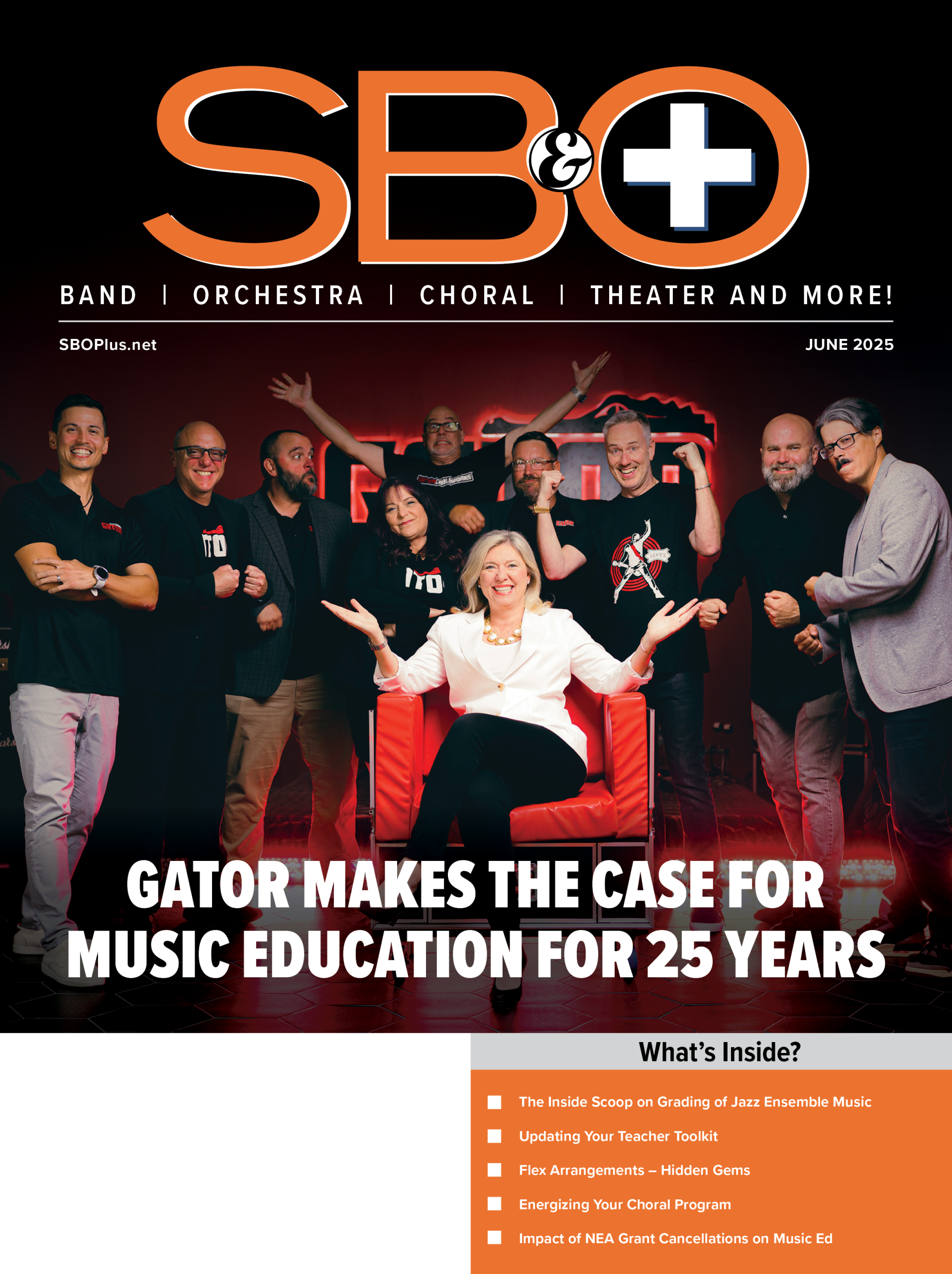 “A lawyer’s relationship to justice and wisdom is on a par with a piano tuner’s relationship to a concert. He neither composes the music, nor interprets it – he merely keeps the machinery running,” says Lucille Kallen, a noted scriptwriter, lyricist, and novelist. After all is said and done, success hinges on attention to the basics; and there’s nothing more essential to music than good intonation.
“A lawyer’s relationship to justice and wisdom is on a par with a piano tuner’s relationship to a concert. He neither composes the music, nor interprets it – he merely keeps the machinery running,” says Lucille Kallen, a noted scriptwriter, lyricist, and novelist. After all is said and done, success hinges on attention to the basics; and there’s nothing more essential to music than good intonation.
Intonation is a daily challenge, guiding students to play consistently in tune with each other and as an ensemble. This requires more than matching a single concert A-440 pitch. Playing different pitches relatively in tune is more demanding and more important than perfect (absolute) pitch. We’ve relied heavily on electronic tuners for more than 50 years without realizing, sometimes, that not all tuners are equal and there are factors affecting the best use of a good electronic tuner.
Before getting into the specifics of tuners, it would be good to review the basic elements that affect intonation quality. In equal temperament, all notes are defined as multiples of the same basic interval. This is okay until you realize that string, brass and woodwinds are basically utilizing their overtone series with “just” intonation based on tuning to intervals with ratios found in their overtone series. Fretless string instruments add another dimension of intonation. A slight increase in the pitch results when pressing the string increases its tension. If the instrument doesn’t compensate for this with a slight increase in the distance from the bridge saddle to the fret, the note sounds sharp. Like unfretted string instruments, the tenor trombone also relies on the musician precisely positioning something, in this case the trombone’s slide. The slide’s pitch adjustment on a single partial is approximately the interval of a tritone on a slide length of over 80 centimeters. Putting multiple families of instruments together in an ensemble creates a challenge of the first order in getting these instruments to play in tune with each other, particularly with chords. Consequently, intervals in these two systems of tuning are not the same. Each “just” interval differs from its nearest equally tempered interval. To hear the differences between just intonation and equal temperament intonation, go to www.kuzmich.com/SBO112011.html.
The Electronic Tuner Market
Electronic tuners detect and display the pitch of notes played on any musical instrument. There are a number of types of electronic tuners: dedicated tuners for guitars and electric basses, chromatic tuners for all instruments, strobe tuners for more precise tuning, clip-on tuners, floor-pedal tuners, rackmount tuners, PC/Mac software tuning applications, and iPhone/Pod applications. Student electronic tuners are typically either clip-on or hand-held, whereas most common classroom display tuners are still the big table model strobes. Each type of tuner has its own advantages.
Clip-on tuners are small, compact, and work well when clipped onto anything that vibrates. While they can be fragile and sometimes inaccurate, they’re very convenient for guitar and electric bass. A hand-held tuner will often include an external microphone with a quarter-inch jack, and some have a DC jack in the event that the unit’s batteries die. Table and strobe tuners have high accuracy and can be used for interval work as well as pitch tuning. They also can be bulky to transport. Rackmount tuners can be integrated into a rack system, pre-wired for each setup, have good visibility on big stages, and can be muted. They are usually only AC powered and, while not usually as handy as portable tuners, security-wise, they’re safe from theft. Pedal tuners are convenient for live performances because they’re easy to transport, integrate well into pedal-board setup/power, easy to mute for silent tuning, and some have a by-pass so signal quality will not be compromised. The pedal tuner LED display can become invisible under bright stage light.
Meet the Players
Peterson Tuners is the oldest continuous and best-known company still exclusively producing electronic tuner technology, as they have since 1937. Korg developed the first portable hand-held tuner in 1975. Peterson, Korg, and Boss tuners are the primary manufactures of today’s electronic tuners. Other emerging players in the tuner market are Sonic Research, Snark, Fender, and Planet Waves, which sell affordable LED-based tuners. Most tuners range in price from $12 to $200 and more sophisticated Peterson Tuners cost up to $3,700, providing full chromatic chordal tuning capabilities. A software strobe tuning application by Peterson Tuners can define lengthy linear tuning of musical passages with detailed graphs and printouts for greater analysis and comprehension.
Sensitivity
The most accurate tuners can be .1% of a cent or 1/1000th of a semitone, which represents the highest accuracy in the industry. Not all tuners will advertise their accuracy. Students at home can easily use tuners that are at least 1% of a cent. But schools should look to use .1% of a cent accuracy, especially since ensemble rooms tend to be noisy. Unacceptable would be plus/minus 3 cents. There is only a 1.9 cent difference between an equally tempered fifth and a perfect fifth and if the tuner can’t recognize the difference, it isn’t going to be much good for training or improving intonation.
Some tuners assess pitch by sampling, which delays the display of the pitch. They record a pitch and make a ballpark, mean average calculation. That takes time and won’t provide a response worth talking about. Look for a real-time, accurate assessment in a tuner. A tone generator is more useful than an average tuner because students can learn to play against a root. The note generator can be used as a tuner and also to tune intervals, like thirds or fifths, against it until they can be heard meshing together. Many inexpensive pocket tuners have tone generators; and most tuners have outputs for external speakers so the tone generator sound is more realistic.
So how can you tell if you are purchasing a real-time assessment tuner instead of sampling technology? Read the promo info. Be aware that many tuners are less accurate sampling units. The intonation accuracy of a good, real-time tuner will be posted in cents or fractions in the tuner’s literature. A sample tuner will not be able to promote any such claim of accuracy. Simply read the advertising materials, manual, or box to discover its worth.
Display
The effectiveness of a tuner is more than sensitivity to pitch differences. Be sure to check out the type of readout display. All tuners use a microprocessor to measure the pitch waveform, which drives the needle or an array of lights. For tuners that use LED displays, the LED lights typically move left or right in response to pitch. The more lights available to display the pitch, the better. Some digital tuners use a virtual needle readout display, so when the note is in tune the needle pauses in a vertical position, with left or right deviations indicating flat or sharp. Tuners with a needle are often supplied with a backlight so the display can be read on a dark stage.
Speaking of displays, instrumental teachers are experiencing success with tuning software that projects a tune onto a large screen or the wall. This focuses students’ attention visually and aurally. When intonation issues arise, students become a cheering squad identifying, fixing, and encouraging accuracy. The two applications I recommend for 28 to 60 inch wall projection are SmartMusic’s tuner displays and Peterson’s StroboSoft. For $99, StroboSoft can use linear, chordal, or match pitch tuning and provide helpful analysis with multiple displays.
Tone-Generating Reference Capabilities
While a tuner’s visual display can be a proactive guide to better intonation, electronic tuners that also have chromatic tone-generating capabilities can guide the student’s intonation even further. Aurally matching out-of-tune notes to individual tuner generated-tones, the student is challenged to adjust to the tuner’s visual display and more importantly eliminate beats to create a pure, in-tune tone. A combined use of the tuner together with its visual and aural assistance provides valuable tuning instruction. Amplifying the tuner’s generating tone through good speakers or a headset will further improve the student’s tuning capabilities, especially if the tuner is just an entry-level portable unit with miniature speakers.
Students should be encouraged to go beyond matching unison pitches and play well tuned thirds, fifths, and sevenths on a given note generated by the tuner. For example, the tuner generates a concert Bb and the student aurally tunes an interval performed above or below that pitch. Perfect intervals are easiest to tune followed by major and minor intervals. Over time, this process will build students’ confidence and sensitivity to the intonation of harmonic intervals, which leads directly to better tuning of chords in an ensemble.
External Microphones
First, when practical, I suggest using an external clip-on microphone connected to a tuner because it is more focused on your playing and not that of your neighbor in an ensemble setting. The clip-on microphone also picks up the vibrations of the instrument itself and transfers it to the tuner very efficiently.
Second, have a long cord connected to the external microphone so the tuner doesn’t end up damaged on the floor when a student inadvertently moves around. Peterson’s external microphone cords are all eight feet long.
Consider using a quality external microphone with the tuner, along with a lengthy cord in the rehearsal room for better isolation and versatility. Also, when intonation problems arise during the rehearsal, it is helpful to have a tuner close at hand for quick assessment and ensemble awareness of accurate intonation.
Closing Comments
Purchasing the right tuner involves matching strong features to specific needs and there are many models to choose from. In this article’s supplemental website is a list of 60 tuners with detailed product descriptions, user feedback, and product photos. I would suggest that schools purchase tabletop tuners because they offer the most features, accuracy, and applications. Students can purchase small portable tuners for effective practice at home. Pay close attention to the quality of each tuner’s visual display for the best accuracy. Beware of tuners that do not provide real-time tuning and be sure to check for accuracy in cents. istening skills can be significantly improved when students become comfortable with a tuner in their practice making sure any out-of-tune notes are regularly monitored then immediately and confidently corrected.
Finally, not all tuners offer multi-temperaments (equal, just, etc.) and their visual displays vary in providing accuracy. Nevertheless, a good electronic tuner is a valuable tool for teaching good intonation.



























